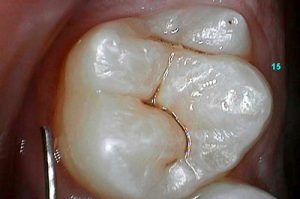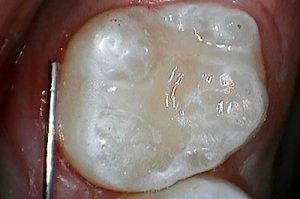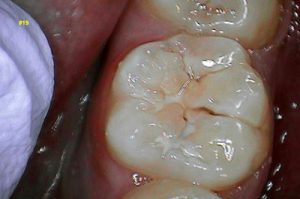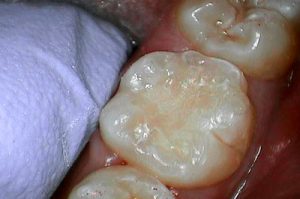Dental Sealants – Protect Teeth from Decay with

Stop Decay Before It Starts with Dental Sealants in Moorestown NJ
The purpose of dental sealants is to protect the chewing surfaces of teeth from decay. The sealants protect teeth from the build-up of germs and food particles in the grooves of the teeth so that cavities are prevented from forming.
What Is a Dental Sealant?
A dental sealant is a thin composite coating that is carefully applied to the grooves on the back teeth. Because molars do the greatest amount of work when chewing food, they receive some of the greatest abuse. They’re also the hardest to clean, especially for young people who may skip brushing or may not do as thorough a job with the toothbrush as they should. As a result, cavities are more likely to develop on the chewing surfaces of the back teeth.


“This patient came in for a sealant. Using air abrasion, we cleaned out all of the staining from the grooves and checked for decay. Once we determined there was no decay, we bonded a dental sealant to the grooves of the tooth. By using this biomimetic technique, the sealant should keep this tooth cavity-free for years to come!”
Who Needs Dental Sealants?
Why is a measure like dental sealants necessary for natural, healthy teeth? When applied properly and to the right candidates, sealants work as a powerful preventive measure. Two of the age groups who benefit the most from dental sealants are children and teens. Most of the tooth decay in younger people develops on the grooves of the teeth. Permanent molars typically erupt around the age of 6 and second molars make their way to the surface around age 12. Putting dental sealants in place soon after the teeth have erupted protects them before they have an opportunity to develop any decay.


The Biomimetic Preparation for Dental Sealants
The application of dental sealants is a careful technique, but one of the most important steps in this process is the prep work. Sealants will fail if the grooves in teeth are not meticulously cleaned and checked for decay prior to sealing the tooth.
A technique called air abrasion utilizes air and particles (silica, baking soda and aluminum oxide) to clean the teeth without removing any healthy tooth structure. Air abrasion is a drill-less technique, providing a gentle and efficient method of removing bacteria, plaque, and decay without noise, heat, pressure, or vibrations. Air abrasion is especially ideal for young children or people with dental anxiety.
Once the bacteria and stains have been thoroughly cleaned out of each tooth to be sealed, it is necessary to check for cavities. A decay stain is applied to the grooves of the tooth before it is sealed. If there is any decay, the stain will indicate the area of decay, alerting your biomimetic dentist that there is an area of the tooth that must be tended to before a dental sealant can be put in place. This step is critical in the long term success of dental sealants.
Biomimetic Application of Dental Sealants
In our biomimetic dental practice, we take the dental sealant prep and application so seriously that only our Dentists complete the dental sealant procedure. Once the tooth has been thoroughly cleaned and examined, the sealant is bonded to the tooth using a flowable composite resin that is known for its longevity and durability.
The dental sealant process is non-invasive, brief, and pain free. There is no drilling or removing of healthy tooth structure. After inspection, the sealant is painted on the tooth and hardens to form a thin protective shield around the tooth in just minutes, filling the grooves and pits of the tooth. Sealants can only be seen on very close inspection, and they closely match the natural color of the surrounding teeth.
The Benefits of Dental Sealants
Even though teeth work hard every day and exert great force, dental sealants can last for five years or more, constantly protecting teeth. Sealants prevent deterioration from occurring at all, because decay, once it starts to settle in, damages a tooth permanently. While tooth-colored fillings effectively manage the repairs a cavity-ridden tooth needs, fillings – though effective – are part of an already compromised tooth. The more decay a tooth suffers and the more repairs it needs, the weaker that tooth becomes. Dental sealants can help a patient avoid this problem entirely.
Your biomimetic dentist will check your or your child’s dental sealants on each visit to make sure that this repair is still in its proper place. If a dental sealant becomes damaged or wears down, bacteria and food particles could get trapped underneath, causing decay. Learn more about dental sealants and whether they are the right option for you from Moorestown Dental Professionals in New Jersey.

